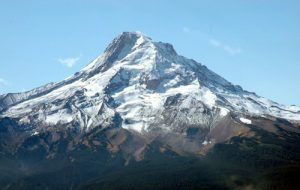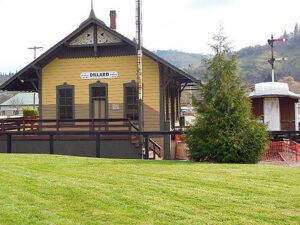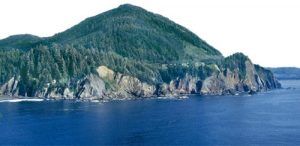Coos County – According to legend, some $40,000 in gold bars were buried by miners during an Indian attack halfway between Sugar Loaf Mountain and Coquille.
Clackamas County – In the area of Government Camp at the base of Mount Hood, a cache of stolen treasure is said to be buried.
Clatsop County – Overlooking the river in Astoria is a landmark on Coxcomb Hill called Astoria Column. Before the 125-foot monument commemorating westward expansion was built in 1925, a cabin stood along Coxcomb Hill Road. Here lived an elderly man who, upon his deathbed, revealed that he had placed $10,000 in a coffee can and hid in a tree stump near his cabin. The cabin stood along the edge of a hill. Though at the time of his death in the 1920s, searches were made for his buried money, it was never found.
Curry County – Where the Rogue River meets the Pacific Ocean at Gold Beach, a number of treasures have been found in the past, leading to possibilities of more.
Crook County – In the 19th century, there was a popular campsite for miners and settlers located on the north side of the Ochoco River near Skeleton Rock and about two miles east of Prineville. Legend has it that buried in the area is an estimated $50,000 in gold bars and coins.
Douglas County – Near the small town of Days Creek, miners were said to have buried pouches of gold nuggets in the late 1800s. The old mining camp sits at the confluence of Days Creek and the South Umpqua River about seven miles northeast of Canyonville.
Douglas County – Over a dozen lost gold mines are said to be located in the Steamboat Mountains near Deadman and White Rock Butte, between the South Umpqua River and North Steamboat Creek.
Douglas County – Located just below the mouth of Salt Creek was a mining camp called China Bar, named such because Chinese prospectors worked there. The Indians, who had long called the area home, were unhappy with these intruders, and an ongoing war occurred between the two factions. During one vicious attack, the miners fled with their gold to a cave near China Bar but were chased down by the Indians and killed. Their gold is still said to be hidden in the cave, which has not been located. China Bar is extremely remote, located on logging roads deep in the mountains in an area called Scuzzy Creek in Fraser Canyon.
Harney County – In the Owyhee Desert, an arid region of canyons, volcanic rock, sagebrush, and grass that lies not only in Oregon but also in northern Nevada and southwestern Idaho, is said to be a hidden mine. In the 1870s, soldiers stationed at Fort Harney were called to fight an Indian uprising. While camping in the Owyhee Desert, one of the soldiers found gold nuggets. With more pressing duties, they were not allowed to explore further. Upon their return to the fort, they told of their find, but no one who had searched could locate the mine again. Some four decades later, however, a sheepherder came upon the same location. While lying on his deathbed, he talked about finding the mine but didn’t provide the specific location. After his death, numerous gold nuggets were found with his belongings.
Hood River County – At Horse Thief Meadows near the Dalles, $25,000 from a stagecoach robbery is believed to be hidden.
Jackson County – In the 1860s, an old miner was said to have buried some $8,000 worth of gold dust near Jacksonville. He returned years later to get the gold, which at that time was said to have been near J.N.T. Miller’s field. Though he dug up a large amount of the field, he could never find his buried cache.
Josephine County – Fifty thousand dollars in gold nuggets was said to have been buried by a miner within three hundred yards of the ghost town of Golden.
Josephine County – In 1878, a German prospector named Karl Meyer took shelter under a rock ledge during a storm along Miller Creek. While waiting out the rain, he spied a badger disappear into a large hole in the nearby rocks. When the rain stopped, he widened the hole and crawled through into a cave. There, he was excited to find a large vein of gold. Breaking off several pieces, he soon had it assayed and found it would be worth $415,000 per ton. He then returned to his camp on Miller Creek but could not find the cave. He continued to search for the elusive cavern for the next six months without success. He later died of tuberculosis, having never found the cave.
Lake County – The Lost Forest Mine in south-central Oregon was discovered by a cowboy who was rounding up cattle in the early 1900s. He planned to meet up with other wranglers at Sand Springs near the Lost Forest. The first to arrive, he found an interesting rock while waiting for the others. Afterward, he took it to Lakeview to be assayed but never returned for the rock or the results. It’s too bad he didn’t return because the rock was found to have been at least 50% gold. When the assayer tried to find the cowboy, he was unsuccessful, and the exact location was never known. It was speculated, however, that the gold still lies at Sand Springs.
Lincoln County – There is a pirate treasure that is said to be buried near Cascade Head near Lincoln City on the Pacific Coast.
Tillamook County – Somewhere on the base of Neahkahnie Mountain, now located north of Manzanita in Oswald West State Park, there is said to be a buried pirate treasure hidden in the late 1500s. Clatsop Indian legend says that the pirates buried a treasure chest on the slopes at the base of the mountain and marked the spot with an inscribed rock. Legend further has it that the treasure is guarded by the ghost of a man who was killed and buried with the loot.
Tillamook County – Legend states that a Spanish ship carrying a large amount of gold disappeared in a storm in 1679. Through the years, a number of artifacts have been found on the sandy shores at Nehalem Beach, leading historians to believe this is where the wreck washed up.
Umatilla County – A March 1915 newspaper tells of what was called Old Squaw’s Buried Treasure on the Umatilla Reservation near Pendleton, Oregon. The tale was told by an old Indian woman upon her deathbed, alleging that she had buried a significant amount of gold some two decades before. After telling her story, numerous farmers and Indians searched for her cache, and one can containing $1,100 in gold was found on land that, at the time, was farmed by P.F. Kirkpatrick. Though the old woman insisted there was more, she was too weak to provide more details and died without the rest ever being found.
Umatilla County – In Umatilla Meadows between Pendleton and Stanfield, at a place called Stage Gulch, a stagecoach was robbed in the early 1900s. The bandits made off with about $1,200 in gold but were quickly captured. The two were to be hanged for their crimes, but before their execution took place, one of them confessed that the loot was buried near the scene of the holdup. Though he surely hoped for a reprieve, the pair were hanged anyway. Though the treasure was searched for, it was never found.
© Kathy Alexander/Legends of America, updated February 2024.
Also See:
Cursed Treasure of Columbia City
Rockhounding in the Prineville Region




